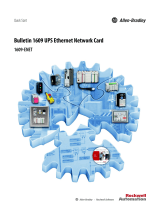
Installation and User Guide
DS6x00 EtherNet/IP Scanner Rev 1.02
© 2004 Datalogic S.p.A. – All Right Reserved Page 3 of 54
Table of Contents
I. INTRODUCTION................................................................................................................. 5
A. OVERVIEW........................................................................................................................... 5
B. REFERENCE TERMS.............................................................................................................. 5
C. REFERENCES........................................................................................................................ 5
II. ETHERNET/IP OVERVIEW ......................................................................................... 6
III. OBJECT MODEL .......................................................................................................... 10
A. IDENTITY OBJECT (0X01)................................................................................................... 11
1. CLASS ATTRIBUTES (INSTANCE 0)..................................................................................... 11
2. INSTANCE ATTRIBUTES (INSTANCE 1)................................................................................ 11
3. COMMON SERVICES ........................................................................................................... 11
4. INSTANCE ATTRIBUTE SEMANTICS .................................................................................... 12
B. MESSAGE ROUTER OBJECT (0X02).................................................................................... 14
C. ASSEMBLY OBJECT (0X04)................................................................................................ 15
1. CLASS ATTRIBUTES (INSTANCE 0)..................................................................................... 15
2. INSTANCE ATTRIBUTES (INSTANCE 0X64 – “INPUT INSTANCE 1”)..................................... 15
3. INSTANCE ATTRIBUTES (INSTANCE 0X65 – “INPUT INSTANCE 2”)..................................... 15
4. INSTANCE ATTRIBUTES (INSTANCE 0X70 – “OUTPUT INSTANCE 1”)................................. 16
5. INSTANCE ATTRIBUTES (INSTANCE 0X71 – “OUTPUT INSTANCE 2”)................................. 16
6. INSTANCE ATTRIBUTES (INSTANCE 0X80 – “CONFIGURATION INSTANCE”)....................... 16
7. INSTANCE ATTRIBUTES (INSTANCE 0X81 – “HEARTBEAT / INPUT ONLY INSTANCE”)....... 16
8. COMMON SERVICES ........................................................................................................... 16
9. CLASS ATTRIBUTE SEMANTICS.......................................................................................... 16
10. INSTANCE ATTRIBUTE SEMANTICS ................................................................................ 17
D. CONNECTION MANAGER OBJECT (0X06)........................................................................... 18
E. TCP OBJECT (0XF5).......................................................................................................... 19
1. CLASS ATTRIBUTES (INSTANCE 0)..................................................................................... 19
2. INSTANCE ATTRIBUTES (INSTANCE 1)................................................................................ 19
3. COMMON SERVICES ........................................................................................................... 19
4. INSTANCE ATTRIBUTE SEMANTICS .................................................................................... 20
F. ETHERNET LINK OBJECT (0XF6)........................................................................................ 23
1. CLASS ATTRIBUTES (INSTANCE 0)..................................................................................... 23
2. INSTANCE ATTRIBUTES (INSTANCE 1)................................................................................ 23
3. COMMON SERVICES ........................................................................................................... 23
4. INSTANCE ATTRIBUTE SEMANTICS .................................................................................... 23
G. ITEM OBJECT (0X64).......................................................................................................... 25
1. CLASS ATTRIBUTES (INSTANCE 0)..................................................................................... 25
2. INSTANCE ATTRIBUTES (INSTANCE 1)................................................................................ 25
3. COMMON SERVICES ........................................................................................................... 25
4. CLASS ATTRIBUTE SEMANTICS.......................................................................................... 25
5. INSTANCE ATTRIBUTE SEMANTICS .................................................................................... 26






















